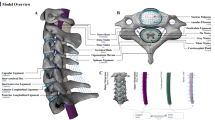Abstract
The essential part of the research lay in ascertaining the sort of forces damaging in an injury of the cervical vertebral column and the circumstances under which this can also lead to spinal cord injury. Further study was devoted to the assessment of the force with which a certain part of the cervical vertebral column resists the injuring forces and in what manner it contributes to the final state of injury. The results of this research made it possible to lay down the principles of prevention from as well as treatment of the cervical vertebral column and spinal cord injury.
Zusammenfassung
Der Hauptteil der vorliegenden Studie befaßt sich mit der Frage, durch welche Art von Gewalteinwirkung die Halswirbelsäule bei einer Verletzung geschädigt wird und unter welchen Umständen dies auch zu Rückenmarksverletzungen führen kann. Ein weiterer Teil der Untersuchung diente der Feststellung, welchen Widerstand ein bestimmter Abschnitt der Halswirbelsäule einer schädigenden Gewalteinwirkung entgegensetzt und inwiefern dieser zum endgültigen Verletzungszustand beiträgt. Aufgrund der Ergebnisse dieser Studie können Prinzipien sowohl zur Vermeidung als auch zur Behandlung von Halswirbelsäulen- und Rückenmarksverletzungen abgeleitet werden.
Similar content being viewed by others
References
Barnes, R.: Mechanism of cord injury without vertebral dislocation. Editorials. J. Bone Jt Surg. 33 B (1951), 494–495.
Berkin, C. R., C. Hirson: Hyperextension injury of the neck with paraplegia. J. Bone Jt Surg. 36 B (1954), 57–61.
Bucy, P. C., R. F. Heimburger, H. R. Oberhill: Compression of the cervical spinal cord by herniated intervertebral disc. J. Neurosurg. 5 (1948), 471–492.
Cramer, F., F. J. McGowan: The role of the nucleus pulposus in the pathogenesis of so-called “Recoil injuries of the spinal cord”. Surg. Gynec. Obstet. 79 (1944), 516–521.
Fišer, Z., K. Bajer: Výzkum pevnosti a pružnosti vazů krční páteře. Aplikace na poznatky o zranění krční páteře a krční míchy. Čas. Lék. čes. 107 (1968), 1196–1202.
Fišer, Z., K. Bajer: Present limits of neurosurgery. Proceedings of the fourth european congress of neurosurgery. Avicenum, Czechoslovak medical press, Prague 1972.
Forsyth, H. F., E. Alexander, C. Davis, R. Underdal: The advantages of early spine fusion in the treatment of fractured-dislocations of the cervical spine. J. Bone Jt Surg. 41 A (1959), 17–36.
Kaplan, C. J.: Cervical hyperextension injuries with paraplegia. J. Bone Jt Surg. 35 B (1953), 79–100.
Krämer, J.: Bandscheibenbedingte Erkrankungen. Thieme, Stuttgart 1978.
Magerl, F.: Operative Frühbehandlung bei traumatischen Querschnittslähmungen. Orthopäde 9 (1980), 34–44.
Morscher, R.: Klassifikation von Wirbelsäulenverletzungen. Orthopäde 9 (1980), 2–6.
Nachemson A.: Measurement of intradiscal pressure. Acta orthop. scand., Suppl. 43 (1956), 260–289.
Panagiotacopulos, N. D., W. G. Knause, R. Bloch: On the mechanical properties of human intervertebral disc material. Biorheology 16 (1979), 317–330.
Plaue, R., H. J. Gerner, R. Salditt: Das elastomechanische Verhalten menschlicher Bandscheiben unter statischem Druck. Arch. orthop. Unfall-Chir. 79 (1974), 139–149.
Scher, A. T.: Injuries to the cervical spine sustained while carrying loads on the head. Paraplegia 16 (1978), 94–101.
Schneider, R. C., G. Cherry, H. Pentek: The syndrom of acute central cord injury. J. Neurosurg. 11 (1954), 546–577.
Schneider, R. C., K. E. Livingston, A. J. T. Cave, G. Hamilton: “Hangmans” fractures of the cervical spine. J. Neurosurg. 22 (1965), 141–154.
Tarlov, I. M.: Spinal cord compression studies. III. Time limits for recovery after gradual compression in dogs. Arch. Neurol. (Chic.) 71 (1954), 588–597.
Taylor, A. R.: The mechanism of injury to the spinal cord in the neck without damage to the spinal cord in the vertebral column. J. Bone Jt Surg. 33 B (1951), 542–547.
Taylor, A. R., W. Blackwood: Paraplegia in hyperextension cervical injuries with normal radiographic appearances. J. Bone Jt Surg. 30 B (1948), 245–248.
Author information
Authors and Affiliations
Rights and permissions
About this article
Cite this article
Fišer, Z. Report on research in strength, elasticity and impact resistance of the cervical vertebrae. Unfallchirurgie 11, 111–114 (1985). https://doi.org/10.1007/BF02587943
Issue Date:
DOI: https://doi.org/10.1007/BF02587943




